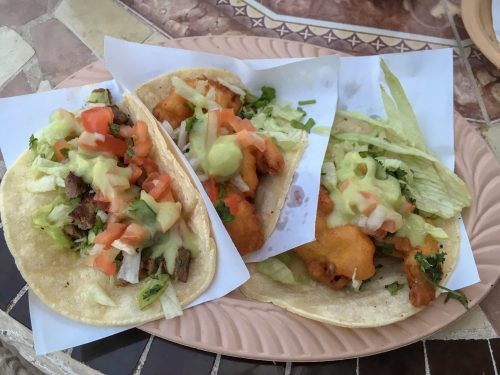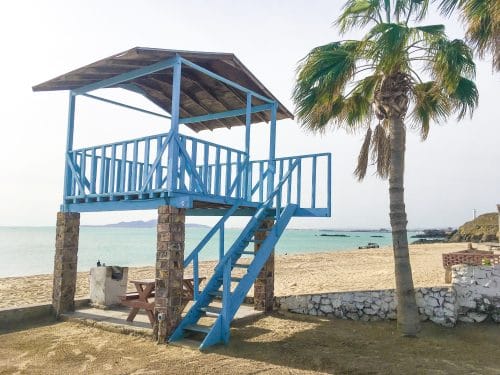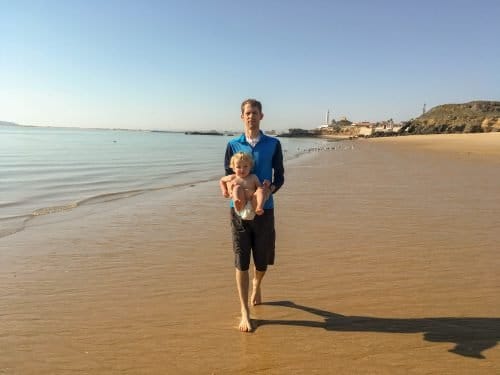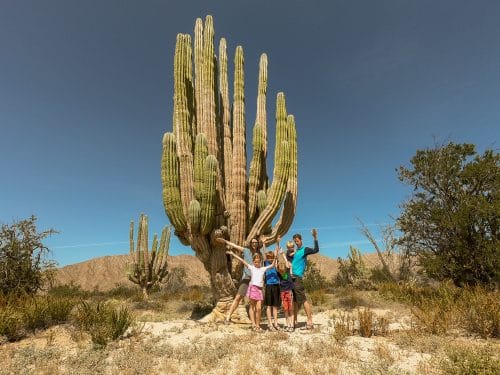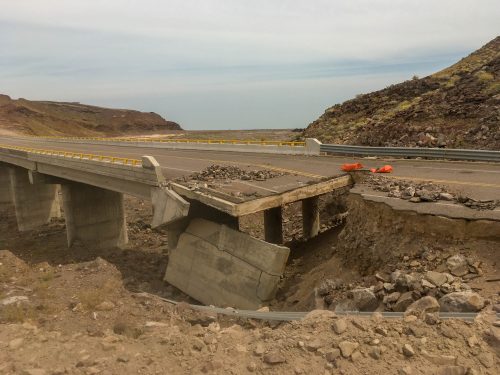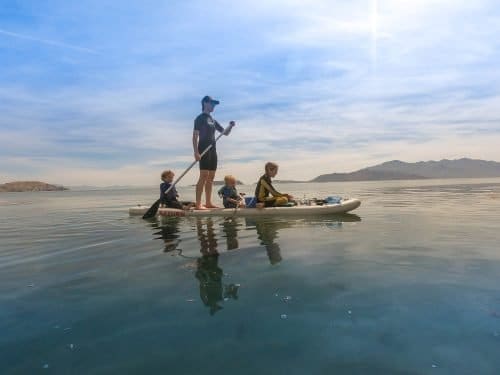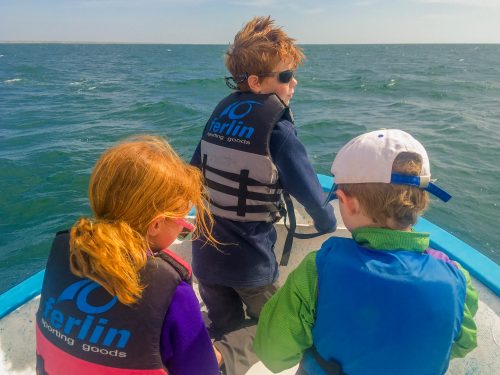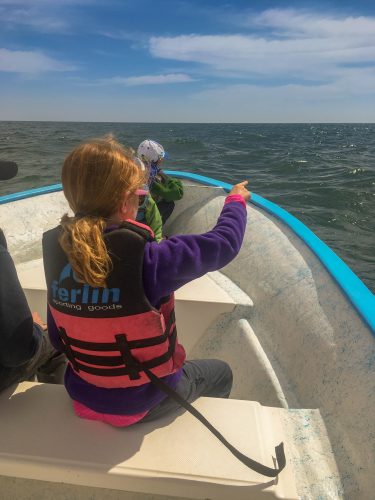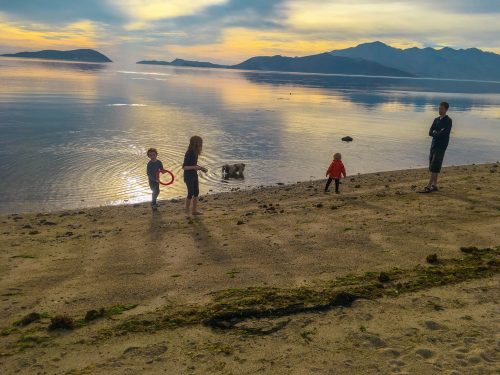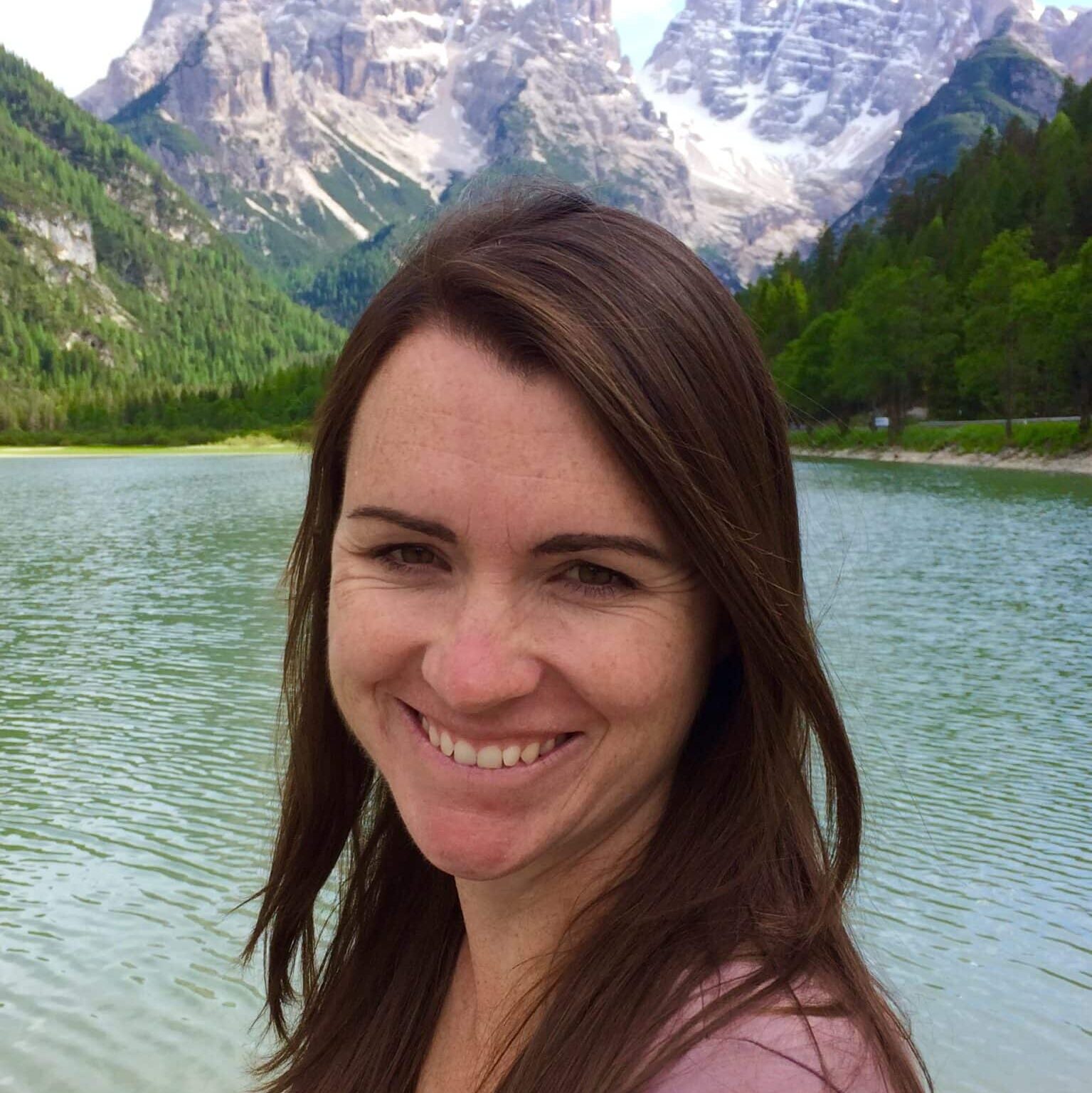This post may contain affiliate links where we earn from qualifying purchases. As an amazon associate, we earn from qualifying purchases. Find out more in our disclosure.
If you’re an American, this could likely be the cheapest international vacation you’ll ever take.
It certainly was for us. In fact, our 11 day trip ended up costing less than $1000 (and that’s only because we did 2 major expeditions).
After a long, cold winter in the mountains, we were all itching for a change. So when a friend planted the idea of visiting Baja Mexico, we were all in. In fact, we only had a couple of days from when we decided to take the trip until we actually left. But that’s okay, because unlike a lot of destinations where you really want to plan out exactly what you’re going to do, Baja is actually a perfect place to just wing it. Outside of the major towns, accommodations will mostly be limited to camping, but camping options are abundant. Also, with large portions of the peninsula not having cell service, that also means that you’re not going to need reservations (usually).
We grabbed our guidebooks, found a few things we were interested in and decided we would just take it one day at a time and just see how far we made it.
Note: We bought two guidebooks and both of them were absolutely invaluable as we referred to them each several times a day. They’re both cheap and will be one of the best tools you have to planning your trip (or winging it like we did). Remember, you’ll have pretty limited cell service a lot of places, so don’t plan on just using the internet to look things up like you can on many other trips.
We live in Utah, and planned to cross the Mexican border at Calexico (more on that comical non-border IN THIS VIDEO). The drive looked to be about 12 hours from home, though we decided to break it up into two days and visit Joshua Tree National Park which was only about an hour out of the way.
What do you need to cross the Mexican Border into Baja?
To cross the Mexican border into Baja Mexico, you’ll need Mexican auto insurance (assuming you’re driving, which you absolutely should do!) and your passports. While we didn’t have our passports even checked upon entry into Mexico, you absolutely need them to re-enter the United States. There were several places in Calexico selling Mexican Auto Insurance, however, everyone told us it was cheaper to buy it online, so we opted for buying ours through Discover Baja and were very pleased at the cheap price (and that we could just buy for the number of days we needed instead of a 6 month policy).
Transporting fresh fruits and vegetables across the border as well as full gas cans is prohibited, however, the border station appeared to only have one person working there, so I think they probably miss a lot. Just to be safe, we filled our car up with gas in Calexico (much cheaper than on the Mexico side), and planned on stocking up on our produce once we were in Mexico. We knew that if all else failed, there would be no shortage of tacos to be found, so we’d be fine!
Honestly, Mexicali isn’t a place I’d stay long in. There isn’t much to see, and compared to what lies ahead, I think it’s best to move south and onto the more scenic and exciting sections of Baja quickly. We came for the beaches, so we headed straight to San Felipe.
(For information on what the roads are like, check out this article).
Read Next: 15 Fun Things to Do in the Yucatan with Kids
Camping in San Felipe Mexico
San Felipe is about 2.5 hours south of Mexicali and is at the north end of the Sea of Cortez. It’s quite a booming town with a full grocery store, many small hotels, and several campgrounds/RV parks. We chose to stay at La Palapa RV park on the north end of town and paid $20 per night. It was right on the beach and we loved the 2 story palapas so much that we just laid our sleeping bags out on the second floor and slept there in the open air. We woke up to a perfect sunrise and the kids were instantly in the sea.
The beaches in San Felipe are some of the nicest in Baja, as the sand is very fine and it’s also very clean. It’s very shallow there as well, which makes it great for splashing around in the water (especially for KIDS), but if you’re looking for more adventure or surfing, the waves of the Pacific are probably more your style.
Where we stayed on the north end of town felt quiet and sleepy (aside from the couple of hours in the evening when the fishermen all put their boats in). However, just a mile south at the malecon, there’s a thriving nightlife. Along the water you’ll find food vendors, street performers and a big selection of restaurants and tourist shops.
While we could have stayed here for a few days, we were in search of some of Baja’s hidden gems, so we headed south.
Along the roads in Baja, stops to get out for a little sightseeing are few and far between, so when we came across The Valley of the Giants (Valle de los Gigantes) we absolutely had to stop. For just $10 for the whole car, we entered a valley full of massive Cordon Cacti. And by massive, I truly do mean massive. These cacti can get over 60 feet tall and weighing over 25 tons. To see the valley, you’ll be driving around on dirt roads through the desert. About 1/3 of the trails are accessible to cars whereas the rest recommend 4×4 (mostly to deal with deep loose sand).
Camping and Hot Springs in Puertecitos Mexico
Our next stop was the town of Puertecitos, famous for its hot springs right at the edge of the sea. Honestly, when we pulled into town, we looked at each other and said “we came here for THIS??”. The initial impression of the town was pretty dismal. The gas station was closed down and we only found one tiny store around. The one campground in town had no water or trash bins, and the palapas and picnic tables were all in poor shape. Initially, they told us that it would cost 550 pesos for the campground + hot springs, but we talked them down to 250 pesos, which still kind of felt overpriced. The beach was the most redeeming part of the campground. While the sand was rougher than we found in San Felipe, the kids still loved playing there.
Thankfully, the hot springs were pretty amazing and redeemed our stop there. To get there, just drive over the hill to the north side of town, and follow the signs.
How often do you get hot springs next to the ocean? We planned on taking a quick 30 minute dip there, which turned into a 3 hour stay! These hot springs can get SUPER HOT. Go when the tide is about halfway in, so that the pools have some cool sea water mixed in to cool them down, or they’ll be too hot to enter!
The campground here was surprisingly full for how run down it was, with about 12 of the 20 spots filled (and many people there for quite a while). However, seeing that we weren’t too impressed, Puertecitos deserves only a 1 night stop in our opinion.
The road from Puertecitos south was severely damaged in many places by last falls hurricane. We saw at least a dozen sections of road that looked like this with detours around them. Make sure to read our post “What are the roads in Baja Mexico like” for more details.
Camping and Fishing in Bahia de los Angeles
Our next destination was Bahia de los Angeles, a coastal town that’s out in the middle of nowhere. After connecting with MX 1, we drove south for a while and then turned back east and drove about 50 miles back to the Sea of Cortez. While Bahia de los Angeles doesn’t seem like an obvious stop, we were there in search of wildlife. There are many camping areas north of town and we stayed at Daggats, which was nice because they had free Wi-Fi in the office (even if they didn’t have functioning water spigots…it’s all about priorities 🙂
The bay here provides a wonderful habitat for may large marine species, because the surrounding islands offer so many protected places for them. The area is commonly known for attracting sea lions, whales, and the most intriguing, WHALE SHARKS! While we knew that nothing was guaranteed, we decided to try our luck.
We knew that whale sharks are commonly in the area from about July-November, though occasionally other times as well. Sadly, after talking to several people in town, we learned that none had been recently spotted. However, having never seen sea lions in the wild, we headed out on a boat ride to see them, knowing that we would be able to jump in and swim with them if we wanted to. Turns out the weather had other plans. Once we found the group of sea lions, the weather had taken a turn for the worse. The water temperature was pretty cold (but we had wetsuits so we were prepared for that), but the air temperature was dropping quickly and the wind was blowing badly. Knowing that we would be on the boat for several more hours, we decided to not get in and swim with them (we would have frozen!).
With no other whale species or dolphins in sight, we started doing some fishing at our sons request. In about an hour, we had caught 13 fish! Seriously, our kids were in heaven. Especially our middle son, who LOVES fishing but had the poor fortune of being born to parents who are horrible at it. Thank goodness, our captain took care of everything from baiting the hooks to showing the kids where to drop their lines.
Afterward, our captain filleted our fish and pointed us to a restaurant that would cook our fish into tacos for us. Even though not all of our kids are fish lovers, they LOVED eating fish tacos from the fish they had just caught!
The rest of our time in Bahia De Los Angeles was spent on the beach. The kids gathered shells, swam, and snorkeled with their fins and masks through the kelp. We had brought our stand-up paddleboards with us and this was a perfect place to use them. The waters are pretty shallow for the first 200 yards from shore so as we paddled along, we could see the bottom of the sea. THe water was pretty cold here, so everyone wore a wetsuit during our visit in March. The kids saw several huge sand dollars and clams as we were out on our paddles, which they were more than happy to dive in and retrieve.
Overall, Bahia De Los Angeles was a quiet town where life really slowed down. There are some basic stores there as well as a gas station, and a couple of restaurants and taco stands. Prices are a bit higher here than we found in the rest of Baja, but that’s mostly because it’s so remote and everything has to be trucked in.
Camping and Whale Watching in Guerro Negro Mexico
Our final stop was Guerro Negro, a destination that a family we met on the beach suggested. They had been there a few days previously, and had had an amazing experience seeing Grey Whales and their calves. We thought that we had missed the whale calving season so we were thrilled to hear this, and quickly added that to our plans. From Bahia De Los Angeles, the drive took us about 2.5 hours to get there.
Instead of staying in the town, we opted to go right to the bay where the whales were and camp there. We stayed at Ojo de Liebre campground which is right where you catch a whale tour from. The cost is $5 for just a camping spot or $10 for a camping spot + palapa, which is what we chose.
This was by far the roughest night of camping that we had along our journey, mostly because of the weather. It was incredibly windy there, and we were quickly thankful that we had paid more for a campsite with a Palapa. Ours was mostly enclosed and we were able to squish our tent inside, otherwise, it would have been constantly blown flat by the wind. In the morning we woke up, and while the wind had died down some, it was still blowing pretty consistently. We knew that whale watching boats started to go out at 9am, so we were loaded up and ready to go.
Unfortunately, the whale watching trips turned out to be A LOT more money than we had anticipated. This could have been a major problem because we only had $200 in cash and there was no way we were driving 40 minutes (and back) to the nearest ATM. The trip cost $50/adult and $40/kid ages 6-12. Thankfully, the ticket seller let all 3 of our younger kids go for free because “they very small”, so we ended up squeaking by paying just $180. Honestly, I was a bit bothered that we had just blown our last wad of cash on this trip, but as soon as we saw our first whale, it was suddenly worth it.
We probably saw about 15 different whales during our 3 hour trip, and 2 of them had calves with them. Most of them were about 150-200 feet away from us, but one mom and calf, stayed near our boat for about 20 minutes curiously looking at us and swimming around us. At one point, they were only about 20 feet away from us, and it was one of the most amazing experiences EVER! Our oldest looked over at me and said “if I jumped in Mom, I’d land right on them!” It’s true.
After riding the high of being so close to the whales, we headed back, only to have a pod of dolphins start swimming alongside us. They were jumping and playing and our kids would all squeal and cheer whenever they saw one jump out of the water. It was the perfect ending to a great trip!
For more information about whale watching in Mexico, check out our post all about it HERE.
Guerrero Negro was our last stop on our way down Baja and we decided to start making our way back. We debated a lot between driving back on the Pacific side or on the Sea of Cortez like we came down. In the end, after looking at the map, we opted to go back the way we came, because we LOVED the sea views we had most of the way, and knew that the Pacific road was more inland.
While both sides of the peninsula have a lot to offer, we love that the Sea of Cortez side was quiet and that we got to visit more remote places. And seriously, that view!



